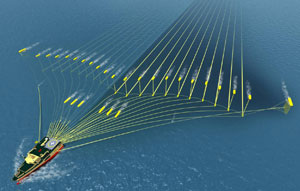A white Christmas in New Brunswick
When I first started working as an offshore Marine Mammal Observer (MMO) I knew it was very likely I would spend many Holiday seasons away from Canada. In fact, 2009 was my first year working as an MMO and I did spend Christmas offshore on a seismic vessel (see post on my first Christmas offshore). It was wonderful though because the crew decorated the galley and the cooks made a Christmas feast although, for some reason, it definitely catered to a carnivore's taste and consisted of turkey, ham, roast beef, suckling pig, ribs, salmon, crab, prawns and potatoes (I don't recall their being other vegetables?)! That's right! The only thing a non-meat eater had to choose from at this Christmas dinner were mashed potatoes! I enjoyed the day though which was made extra magical and Christmas-ey when one of the other MMOs surprised me and the other MMO with a stocking stuffed full of treats hung on our cabin doors :)
Luckily, the way the rotations landed on the Egypt contract this winter (see previous and following posts) I was able to come back to Canada and spend the holidays with my family in New Brunswick. This would be my first Christmas in Eastern Canada and my first white Christmas in ages.
So why did I end up spending Christmas in New Brunswick instead of Vancouver Island? When I completed my undergraduate degree in 2004 I ended up working and studying in various places until 2008. During this time I worked at the Center For Whale Research on San Juan Island, WA, with the Coastal Ecosystem Research Foundation (CERF) on the central BC coast and San Ignacio Lagoon, Mexico, with Global Vision International (GVI) in Kenya and then studied my masters course in Marine Mammal Science at St Andrews, Scotland. Until I completed my masters nearly all of my immediate family were on Vancouver Island but within a couple years of me returning to Victoria my parents and then my brother and grandparents moved to eastern Canada where the family had a fair sized piece of property that needed attention i.e. somebody tending to it once in a while!
Vancouver Island, on the very southwest coast of Canada
New Brunswick is in red
New Brunswick is in red
Although I couldn't really complain having been away for so long myself, I was sad most of my immediate family now lived on the other side of the country. The full trip from Victoria to New Brunswick takes more time than it does to fly from Vancouver to London! With all the connections and the fact that the distance from Victoria to New Brunswick is 5353 km (this trip would take a full 2.5 days to drive) they journey by plane is one very full day. Of course, I was willing to make the trip to spend Christmas with family this year and was certainly glad I did!
Following are some photos from this lovely WHITE Christmas!! Something we don't really get on Vancouver Island...although we nearly missed out in New Brunswick too as the snow arrived later than expected this year!
Yoko, my parent's (and sister's) sweet Shiba Inu
Scenes around the Village of Gagetown (not CFB Gagetown!), New Brunswick
Doctor's Hill B and B - lovely, lovely home!
Beautiful but c-c-c-cold!
The Village of Gagetown is a busy place this time of year!
Gas dock - in hibernation mode, onshore, in the winter
Taking some time out :)
Visiting my parents' friends' farm where they bred fine quality Percheron horses
This big guy, Chicago, was the prize winning stallion. A big, beautiful horse indeed!
Absolutely loved this photo...so New Brunswick! Randy, the breeder, and my grandfather sitting under all the 'trophies'


















































































